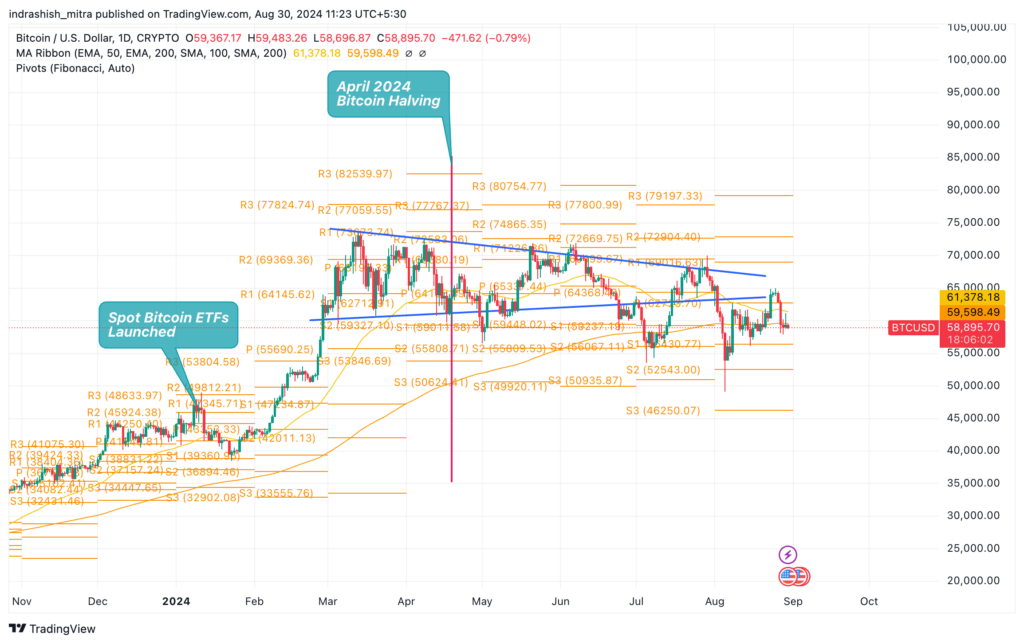Table of Contents
ToggleKey Takeaways:
- Mining Difficulty Adjustment: Bitcoin mining difficulty recently saw a 3% positive adjustment, making it more challenging for miners to validate transactions and add new blocks to the blockchain.
- Automatic Adjustments: The mining difficulty is adjusted approximately every two weeks based on the network’s total computational power, ensuring consistent block production and controlled Bitcoin supply.
- Impact on Miners: A positive difficulty adjustment slows down the rate at which miners can produce new blocks, influencing the pace of Bitcoin generation and affecting overall mining profitability.
- Hashrate Influence: The rise in mining difficulty correlates with an increase in the Bitcoin hashrate, as miners expand operations and add more computational power to their facilities.
- Network Stability: Difficulty adjustments play a crucial role in maintaining Bitcoin’s network stability and security, balancing the crypto’s supply and demand to safeguard Bitcoin price.
The Bitcoin network has recently undergone a 3% positive adjustment in its mining difficulty, a crucial metric that determines how challenging it is for miners to validate transactions and add new blocks to the blockchain. This adjustment is a routine part of the Bitcoin protocol, designed to maintain the stability and security of the network. As the mining difficulty increases, it becomes harder for miners to produce new blocks, which in turn affects the overall pace at which new Bitcoin is generated.
Understanding Bitcoin Mining Difficulty
Bitcoin mining difficulty is an essential feature embedded in the Bitcoin blockchain, playing a critical role in regulating the network’s operation. Every approximately two weeks, or 2,016 blocks, the network automatically adjusts the difficulty level based on the total computing power (hashrate) currently contributing to the blockchain. This adjustment ensures that blocks are produced at a consistent rate, regardless of fluctuations in the number of miners or the amount of computational power they employ.
A positive difficulty adjustment, such as the recent 3% increase, means that miners will find it more challenging to validate transactions and add new blocks. This increased difficulty slows down the rate at which new blocks are added to the blockchain, effectively controlling the supply of Bitcoin entering circulation.
Conversely, a negative adjustment would imply that miners can process transactions and produce new blocks more quickly, potentially leading to a faster increase in the Bitcoin supply. These adjustments are crucial for maintaining the delicate balance between Bitcoin’s supply and demand, ultimately influencing the crypto’s market value.
Read on: Bitcoin Price Prediction
Recent Trends in Bitcoin Mining
The recent 3% increase in Bitcoin’s mining difficulty reflects a broader trend in the crypto’s mining ecosystem. Over the past year, the hashrate—the total computational power dedicated to mining Bitcoin—has seen significant fluctuations. After a period of decline, miners have gradually been ramping up their operations, adding more mining rigs to their facilities. This increase in hashrate naturally leads to a higher difficulty level, as the network adjusts to accommodate the additional computational power.
The following chart illustrates the recent changes in Bitcoin’s mining difficulty, highlighting the 3% increase that occurred during the latest adjustment period:

Source: Blockchain.com/explorer
As seen in the chart, the recent spike in difficulty marks a continuation of the upward trend that has been observed over the past few months. This trend suggests that miners are increasingly confident in the profitability of their operations, despite the inherent challenges posed by higher difficulty levels.
The Role of Hashrate in Difficulty Adjustments
The hashrate is a key factor in determining the difficulty of mining Bitcoin. As miners add more computational power to the network, the hashrate increases, prompting the protocol to adjust the difficulty upwards. This adjustment is necessary to prevent an oversupply of Bitcoin, which could destabilize the Bitcoin price.
The chart below shows the 7-day average of the Bitcoin mining hashrate over the past year:

Source: Blockchain.com/explorer
The recent rise in hashrate indicates that miners have been expanding their operations, reversing the downsizing that occurred earlier in the year. This expansion is likely driven by the increasing price of Bitcoin, which makes mining more profitable despite the higher difficulty levels.
Implications for Bitcoin Price in Future
The recent positive adjustment in Bitcoin’s mining difficulty underscores the dynamic nature of the Bitcoin network. As miners continue to invest in more powerful equipment and expand their operations, the network adapts to ensure that Bitcoin’s supply remains controlled and predictable.
For investors and traders, these adjustments are a reminder of the complex mechanisms that govern Bitcoin price. While the recent increase in difficulty may slow the pace of new Bitcoin production, it also enhances the network’s security and stability, which are critical factors in maintaining long-term confidence in Bitcoin.
As Bitcoin continues to evolve, monitoring these adjustments and understanding their implications will be crucial for anyone involved in the crypto space. Whether you’re a miner, investor, or casual observer, staying informed about these developments is key to navigating the ever-changing landscape of digital currencies.
In summary, the recent 3% increase in Bitcoin mining difficulty reflects a broader trend of growing computational power within the network. This adjustment, while making mining more challenging, plays a vital role in maintaining the balance between Bitcoin’s supply and demand, ensuring the continued stability of the Bitcoin ecosystem.
Source: Bitcoinist
Related posts
Bitcoin Price Hits New All-Time High Following Fed’s 25-Basis-Point Rate Cut
Fed’s interest rate cut spurs crypto momentum, boosting Bitcoin and Ethereum prices.
Read more
Blum Secures Major Investment from TOP to Strengthen DeFi Presence in TON Ecosystem
TOP’s backing aims to accelerate Blum’s multi-blockchain expansion.
Read more



